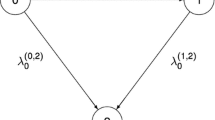Abstract
We consider a random censoring model for survival analysis, allowing the possibility that only a proportion of individuals in the population are susceptible to death or failure, and the remainder are immune or cured. Susceptibles suffer the event under study eventually, but the time at which this occurs may not be observed due to censoring. Immune individuals have infinite lifetimes which are always censored in the sample. Assuming that the distribution of the susceptibles’ lifetimes as well as the censoring distribution have infinite right endpoints and are in the domain of attraction of the Gumbel distribution, we obtain asymptotic distributions, as sample size tends to infinity, of statistics relevant to testing for the possible existence of immunes in the population.


Similar content being viewed by others
References
Amica, M., Van Keilegom, I.: Cure models in survival analysis. Ann. Rev Statist. Appl. 5, 311–342 (2018)
Beirlant, J., Carbonez, A., van der Meulen, E.: Long run proportional hazards models of random censorship. J. Statist. Plann Inference 32(1), 25–44 (1992)
Beirlant, J., Worms, J., Worms, R.: Estimation of the extreme value index in a censorship framework: asymptotic and finite sample behavior. J. Statist. Plann. Inference 202, 31–56 (2019)
Bingham, N. H., Goldie, C. M., Teugels, J. L.: Regular variation. Cambridge University Press (1987)
Cox, D. R.: The analysis of exponentially distributed life-times with two types of failure. J. Roy. Statist. Soc., Ser. B (Methodol.) 21, 411–421 (1959)
Csörgo, S.: Estimation in the proportional hazards model of random censorship. Statistics 19, 437–463 (1988)
de Haan, L.: Equivalence classes of regularly varying functions. Stoch. Process. Appl. 2:243–259 (1974)
de Haan, L., Ferreira, A.: Extreme Value Theory: An Introduction. Springer, New York (2006)
Einmahl, J. H. J., Fils-Villetard, A., Guillou, A.: Statistics of extremes under random censoring. Bernoulli 14(1), 207–227 (2008)
Escobar-Bach, M., Maller, R.A., Van Keilegom, I., Zhao, M.: Estimation of the cure rate for distributions in the Gumbel maximum domain of attraction under insufficient follow-up. Biometrika. https://doi.org/10.1093/biomet/asaa106 (2021)
Escobar-Bach, M., Van Keilegom, I.: Non-parametric cure rate estimation under insufficient follow-up using extremes. J. Roy. Statist. Soc. Ser. B (Methodol.) 81, 861–880 (2018)
Gill, R. D.: Censoring and Stochastic Integrals. Mathematical Centre Tracts, vol. 124. Mathematisch Centrum, Amsterdam (1980)
Kalbfleisch, J. D., Prentice, R. L.: Estimation of the average hazard ratio. Biometrika 68(1), 105–112 (1981)
Kaplan, E. L., Meier, P.: Nonparametric estimation from incomplete observations. J. Amer. Statist. Assoc. 53, 457–481 (1958)
Koziol, J. A., Green, S. B.: A Cramér-von Mises statistic for randomly censored data. Biometrika 63(3), 465–474 (1976)
Maller, R. A., Resnick, S.I.: Limiting behavior of sums and the term of maximum modulus. Proc. Lond. Math. Soc., III Ser. 49, 385–422 (1984)
Maller, R. A., Zhou, S.: The probability that the largest observation is censored. J. Appl. Probab. 30, 602–615 (1993)
Maller, R. A., Zhou, X.: Survival Analysis with Longterm Survivors, 1st edn. Wiley, Chichester (1996)
DCCPS National Cancer Institute: Surveillance, epidemiology, and end results (seer) program research data. Surveillance Research Program, released April 2019, based on the November 2018 submission, pp 1975–2016 (2019)
Othus, M., Barlogie, B., LeBlanc, M. L., Crowley, J. J.: Cure models as a useful statistical tool for analyzing survival. Clin. Cancer Res. 18, 311–342 (2012)
Peng, Y., Taylor, J. M. G.: Cure Models. In: Klein, J., van Houwelingen, H., Ibrahim, J. G., Scheike, T. H. (eds.) Handbook of Survival Analysis, Handbooks of Modern Statistical Methods Series, Chapter 6, pp 113–134. Chapman & Hall, Boca Raton (2014)
Resnick, S.I.: Asymptotic location and recurrence properties of maxima of a sequence of random variables defined on a Markov chain. Z. Wahrscheinlichkeitstheorie Verw Gebiete 18, 197–217 (1971)
Resnick, S. I.: A Probability Path. Birkhäuser, Boston (1999)
Resnick, S.I.: Extreme Values, Regular Variation and Point Processes. Springer, New York. Reprint of the 1987 original (2008)
Taweab, F., Ibrahim, N. A.: Cure rate models: a review of recent progress with a study of change-point cure models when cured is partially known. J. Appl. Sci. 14, 609–616 (2014)
Whitt, W.: Some useful functions for functional limit theorems. Math. Oper. Res. 5(1), 67–85 (1980)
Whitt, W.: Stochastic Processs Limits: An Introduction to Stochastic-Process Limits And Their Application to Queues. Springer, New York (2002)
Worms, J., Worms, R.: Estimation of extremes for Weibull-tail distributions in the presence of random censoring. Extremes 22(4), 667–704 (2019)
Acknowledgements
We are grateful to referees for a close reading of the paper, thoroughgoing criticism, and suggesting relevant references. Thanks also to Muzhi Zhao for help with the figures, and the analyses in Table 1.
Author information
Authors and Affiliations
Corresponding author
Additional information
Publisher’s note
Springer Nature remains neutral with regard to jurisdictional claims in published maps and institutional affiliations.
Rights and permissions
About this article
Cite this article
Maller, R., Resnick, S. Extremes of censored and uncensored lifetimes in survival data. Extremes 25, 331–361 (2022). https://doi.org/10.1007/s10687-021-00426-2
Received:
Revised:
Accepted:
Published:
Issue Date:
DOI: https://doi.org/10.1007/s10687-021-00426-2




